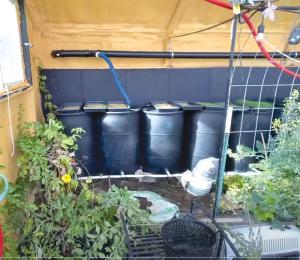2024 - Volume #48, Issue #1, Page #23
[ Sample Stories From This Issue | List of All Stories In This Issue | Print this story
| Read this issue]
Utah Greenhouse Heats, Cools Itself
 |
 |
“We finished the greenhouse in July 2022, and despite one of our hardest winters, we grew bananas, avocados, and mangoes in the snow, as well as tomatoes, cucumbers, squash, carrots, peas and more,” says Christensen. “This summer, it has handled the high heat just as well, never getting over 100 degrees inside.”
Also known as a pit greenhouse, the basic style was used in Victorian-era Britain and pre-revolution Russia. With its in-ground design, it offers year-round production in a wide variety of climates. In recent years, it’s regained its earlier popularity. Christensen gathered ideas from multiple sources to design his hybrid.
“The biggest challenge was having the confidence to build one that was unique,” he says. “I knew I wanted it as off-grid as possible. I based the roof angle with its 55-degree pitch on what others had done in this area. It restricts enough sunlight in the summer to help hold down temperatures.”
Rather than use a kit, Christensen designed trusses and had them fabricated. Like other walipinis, he set the lower 4 ft. below ground level to take advantage of geothermal warming in the winter and cooling in the summer.
Credit for the winter warmth and summer cooling is shared by the insulated in-ground and above-ground walls, the heat bank of 68 blue water barrels running the length of the back side of the structure, the angle of the roof line, the 24-in. insulated blanket above the front 18-in. stem wall, and the cold air drops. Foam sprayed on the end walls, rear wall, and roof helps to seal out cold air. Screened windows and doors at each end facilitate air movement in the summer.
The 4-ft. grow wall at the front of the greenhouse has a double layer of insulation. The 8-ft. rear wall has a double layer of 2-in. insulation sheets in between 2 by 4 framing with the second layer perpendicular to the first to prevent gaps.
In the summer, raising the blanket at the front provides massive air input, which vents through the roof vents, doors, and windows.
“There’s a ton of airflow in the summer, and the plants love it,” says Christensen. “What really helps is the mass of plants and the water in the soil. It acts like a giant swamp cooler.”
In the winter, the heat reservoir of blue barrels gets an active assist from convection created by the cold air drops.
The drops are two high, 55-gal. barrels buried 6 ft. in the ground beneath the center walkway. Grills over them allow cold air in the winter to pass down and through a network of 8-in. single-wall corrugated poly pipe that connects them. As the air is warmed by the ground, it rises through pipes buried at a gentle incline to the rear of the greenhouse in front of the barrels.
The 30-in. high raised planting beds are 3 ft. wide at the front of the greenhouse and 5 ft. wide at the rear. However, the 2 ft. next to the rear wall is taken up by the line of water barrels.
Combined with outside gardens for corn, tomatoes, potatoes, extra onions and carrots, the greenhouse is helping to meet a key goal for Christensen. He and his wife plan to grow as much food for themselves and their eight children as possible.
“We noted recently that we don’t buy produce at the store at all anymore,” says Christensen. “The kids go in for a handful of blackberries or strawberries or to get stuff to make salsa. It’s available, and we know where it came from, fresh and right in our backyard.”
Christensen posted several videos on the greenhouse building process on his Manti Homestead YouTube channel. He did so in the hopes that others would take the plunge. If not to build their own greenhouse, then simply to grow at least some of their own food.
Contact: FARM SHOW Followup, Nate Christensen, 436 N 100 W, Manti, Utah 84642 (ph 435-813-2250; nate.christensen@zionsbank.com)

Click here to download page story appeared in.

Click here to read entire issue
To read the rest of this story, download this issue below or click here to register with your account number.




